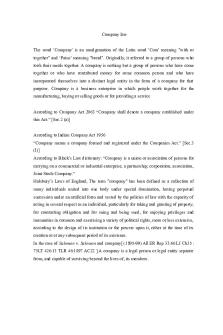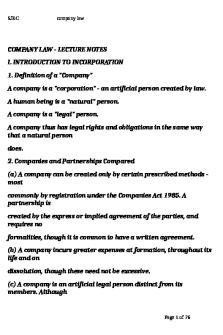Company Law Tutorial Exercise PDF

| Title | Company Law Tutorial Exercise |
|---|---|
| Author | bowen Chen |
| Course | Company Law |
| Institution | University of Western Australia |
| Pages | 2 |
| File Size | 84.2 KB |
| File Type | |
| Total Downloads | 2 |
| Total Views | 148 |
Summary
tutorial answer...
Description
TUTORIAL EXERCISE NO 3 Question 1 1 Only a person registered as a member can gain rights under the provisions of the Corporations Act applicable to members. Proof of the matters contained in it : s176, accrue who the members are. and containing information about the members, number of shares, amount unpaid on shares they own: s169. Then confirm rights for the number of shares on the register to support the reservation. The significance is support to reflect information and the detail about. 2 under s173 inspection free for members payment of the fee for others. We also can find the location in the computer online. 3 to correct register, an application must be made to the court: s175. Application may be the company or a person aggrieved. (who badly affected by the mistakes) The correction of register may also occur when there is a breach in the Constitution or Replaceable Rules. (Carew-Reid v The Public Trustee).
Question 2 under s1072F(3) (RR). Directors have discretion to refuse on grounds of shares not fully-paid or company has lien (security interest) on shares which call is unpaid. For private companies, s1072G (RR) gives directors a discretion to refuse to register a transfer for any reason (any reason that is reasonable for preserving the reputation of the company). Under s1071F – Remedy for refusal. Applicant is on transferee. The transferee or transmittee may apply to the Court for an order under this section. The transferee must prove that the refusal was “without just cause”. (If there is a reason for refusal given by directors, it is easier for transferee to show that the reason is not a bona fide reason). Cases: (successful rejection by BOD) Re Smith and Fawcett Ltd, AMLA v Ure; (Successful challenge by transferee): Re Winmardun Pty Ltd, Roberts v Coussens.
Question 3 1. The issue is whether Stanley can successfully replace the directors of the company given his shareholding. Relative law: Board on written request by members with 5%+ votes - s249D which may be cast at GM On failure by Board, members with more than 50% of votes of requesting members - s249E (Costs to be borne by Company: s249E(4)) Applicantion: Don’t have to be 50% shares to vote the meeting only need is 5% votes. Because Stanley would like to replace the existing directors, the suggestion comes from the member rather than from the directors’ company. The purpose of general meeting in s249. That he has shares to ask the directors to hold that meeting. He only have 47% shares so failure of s249E(1) or he can get some of the shareholders holding more than 5% of the votes that he can hold the meeting.s249F(1). Also under s203(D) find the rules to removal directors by members. The normal time to free is 2 months. 2. s1322(2) a proceeding is not invalidated because of any procedural irregularity unless the Court is of the opinion that the irregularity has caused or may cause substantial injustice that cannot be remedied by any order of the Court and by order declares the proceeding be invalid. The issue is that if Stantly has suffered substantial injustice. On the given facts, it is likely that Stanley has suffered substantial injustice. The test to determine if substantial injustice has been caused is to ask: “Would the outcome be different if the decision was done with procedural regularity?” in this case the outcome will be different. So Stanley would be suffered substantial injustice.
Question 4 a)Public company
under section 9 is a company other than a proprietary company. Public companies have an
infinite number of members and there is no limitation in public fundraising. Public companies must have one company secretary. Types of public companies • Limited by shares • Limited by guarantee • Unlimited with share capital • No liability company a proprietary limited company are that there are no more than 50 non-employee shareholders s.113 (1). There is no public fundraising except for offer of shares to existing shareholders or employee’s s.113 Types of proprietary companies • Limited by shares • Unlimited with share capital
b) REVENUE LESS THAN $25 MILL PA? GROSS ASSETS LESS THAN $12.5 MILL? LESS THAN 50 EMPLOYEES? IF ANSWER TO 2/3 IS YES, SMALL s45A(2) IF ANSWER TO 2/3 IS NO, LARGE s45A(3) LARGE PROPRIETARY CO Prepare annual financial report and director’s report – s292 Financial reports must be audited – s301 SMALL PROPRIETARY CO Requirement only if ASIC ( s294) or holder(s) of 5% of shares request (s293)
c)
Under section 9, a holding company is in relation to a body corporate, means a body corporate of which the
first body corporate is a subsidiary.
Question 5 Permitted Conversions : s162 Eg Pty to Ltd Ltd to NL Method: ·
Pass a special resolution : s162(1)(a), s9
·
Lodge application with ASIC with copy of special
·
ASIC gives notice on ASIC database and in the Gazette:
resolution and other applicable documents : s163 s164(3)
·
After one month, ASIC alters details to reflect change :
s164(4)
·
Gives company new certificate : s164(6)
NB Does not create a new company : s166 A proprietary company limited by shares may change to any Unlimited Pty Co, Unlimited Public Co or a Public Company limited by shares. Only a Public Company Limited is able to convert to a No Liability Company. A proprietary company limited by shares may change to any Unlimited Pty Co, Unlimited Public Co or a Public Company limited by shares. Only a Public Company Limited is able to convert to a No Liability Company. Ajax will be permitted to change to a No Liability Company. In order to change to a NL Co., a special resolution must be passed s162(1)(a) (more than 75% majority)....
Similar Free PDFs

Company Law Tutorial Exercise
- 2 Pages

Company law
- 55 Pages

SEC Company exercise (Apple)
- 2 Pages

Company Law - kkkkkkkkkkkkk
- 206 Pages

MCQ Company Law
- 25 Pages

Company Law 2018
- 89 Pages

Company law lecture notes
- 9 Pages

COMPANY LAW -LECTURE NOTES
- 48 Pages

Company Law Outlines
- 67 Pages

Company law Full Notes
- 43 Pages

Company Law Notes
- 32 Pages

Company law notes
- 52 Pages

Tutorial Exercise NO 3
- 1 Pages

Company law notes
- 23 Pages

Company Law Essay PLAN
- 4 Pages

Company Law Assignment
- 5 Pages
Popular Institutions
- Tinajero National High School - Annex
- Politeknik Caltex Riau
- Yokohama City University
- SGT University
- University of Al-Qadisiyah
- Divine Word College of Vigan
- Techniek College Rotterdam
- Universidade de Santiago
- Universiti Teknologi MARA Cawangan Johor Kampus Pasir Gudang
- Poltekkes Kemenkes Yogyakarta
- Baguio City National High School
- Colegio san marcos
- preparatoria uno
- Centro de Bachillerato Tecnológico Industrial y de Servicios No. 107
- Dalian Maritime University
- Quang Trung Secondary School
- Colegio Tecnológico en Informática
- Corporación Regional de Educación Superior
- Grupo CEDVA
- Dar Al Uloom University
- Centro de Estudios Preuniversitarios de la Universidad Nacional de Ingeniería
- 上智大学
- Aakash International School, Nuna Majara
- San Felipe Neri Catholic School
- Kang Chiao International School - New Taipei City
- Misamis Occidental National High School
- Institución Educativa Escuela Normal Juan Ladrilleros
- Kolehiyo ng Pantukan
- Batanes State College
- Instituto Continental
- Sekolah Menengah Kejuruan Kesehatan Kaltara (Tarakan)
- Colegio de La Inmaculada Concepcion - Cebu